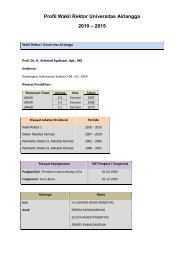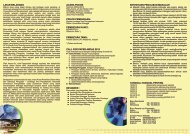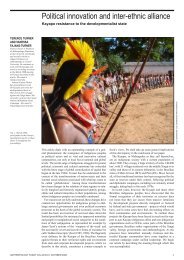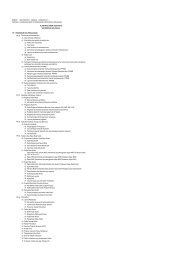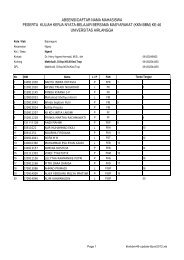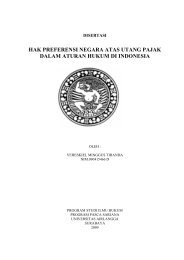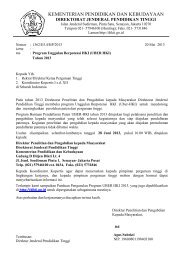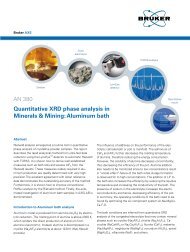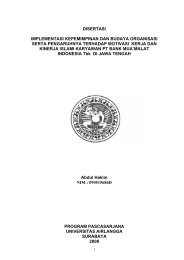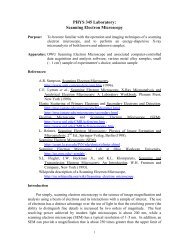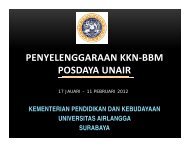Medicinal properties of mangosteen (Garcinia mangostana)
Medicinal properties of mangosteen (Garcinia mangostana)
Medicinal properties of mangosteen (Garcinia mangostana)
Create successful ePaper yourself
Turn your PDF publications into a flip-book with our unique Google optimized e-Paper software.
3232 J. Pedraza-Chaverri et al. / Food and Chemical Toxicology 46 (2008) 3227–3239<br />
Table 7<br />
Antioxidant <strong>properties</strong> <strong>of</strong> G. <strong>mangostana</strong><br />
G. <strong>mangostana</strong> extracts and/or xanthone References<br />
The methanol extract <strong>of</strong> the fruit hulls <strong>of</strong> GML showed DPPH scavenging activity Yoshikawa et al. (1994)<br />
a-Mangostin inhibited copper-induced LDL oxidation in vitro Williams et al. (1995)<br />
a and c-Mangostin showed antioxidant activity using the ferric thiocyanate method Fan and Su (1997)<br />
The copper-induced LDL oxidation in vitro was inhibited by a-mangostin and by prenylated xanthones derived from this xanthone Mahabusarakam et al. (2000)<br />
Methanolic extract <strong>of</strong> the edible portion <strong>of</strong> GML exhibited antioxidant activity using DPPH and ABTS assays Leong and Shui (2002)<br />
The crude methanol extract <strong>of</strong> pericarp from GML ameliorated the intracellular production <strong>of</strong> ROS in SKBR3 cells Moongkarndi et al. (2004a)<br />
The pericarp extract <strong>of</strong> GML was able to scavenge HO and effective to inhibit lipid peroxidation Garcia et al. (2005)<br />
Several xanthones showed scavenging ONOO ability in vitro Jung et al. (2006)<br />
The aqueous and ethanolic extracts <strong>of</strong> the pericarp <strong>of</strong> GML present DPPH scavenging activity and protects neuroblastoma cell line<br />
NG108-15 from H2O2 citotoxicity<br />
Weecharangsan et al. (2006)<br />
The ethanolic extract <strong>of</strong> GM showed antioxidant activity against DPPH radicals and reduced the ROS production <strong>of</strong> PML Chomnawang et al. (2007)<br />
Mangosteen-fruit showed antioxidant activity against DPPH and ABTS radicals and prevents the decrease in antioxidant activity<br />
induced by a cholesterol supplemented diet in rats<br />
Haruenkit et al. (2007)<br />
a-Mangostin showed protective effect against isoproterenol-induced oxidative damage and myocardial injury in rats Devi Sampath and Vijayaraghavan<br />
(2007)<br />
c-Mangostin showed HO -scavenging activity Chin et al. (2008)<br />
3. Xanthones from whole fruit, trunk, branches, and leaves <strong>of</strong><br />
GML<br />
Three new xanthones were isolated from the whole <strong>mangosteen</strong>-fruit:<br />
mangostenone C, D and E (Suksamrarn et al., 2006)<br />
(Table 3). In total, 18 xanthones have been isolated from the whole<br />
<strong>mangosteen</strong>-fruit. In addition, 21 xanthones have been isolated<br />
from trunk and branches <strong>of</strong> GML (Holloway and Scheinmann,<br />
1975; Nilar et al., 2005; Nilar and Harrison, 2002; Ee et al., 2006)<br />
(Table 4). On the other hand, 1,6-dihydroxy-3-methoxy-2-isoprenyl-xanthone,1-hydroxy-6-acetoxy-3-methoxy-2-isoprenylxanthone<br />
and gartanin were isolated from <strong>mangosteen</strong> leaves<br />
(Parveen and Khan, 1988) (Table 5). Chin et al. (2008) isolated<br />
and identificated two new compounds <strong>of</strong> <strong>mangosteen</strong> powder<br />
fruit 1,2-dihydro-1,8,10-trihydroxy-2-(2-hydroxypropan-2-yl)-9-<br />
(3-methylbut-2-enyl)furo[3,2-a]xanthen-11-one and 6-deoxy-7demethylmangostanin.<br />
Also, 31 synthetic derivatives have been obtained from amangostin,<br />
and they have been used to perform several studies<br />
(Table 6).<br />
4. Main biological and medicinal <strong>properties</strong> <strong>of</strong> GML<br />
4.1. Antioxidant <strong>properties</strong><br />
In the Table 7 the antioxidant <strong>properties</strong> <strong>of</strong> <strong>mangosteen</strong>-fruit<br />
extracts and some xanthones that have been studied are<br />
summarized.<br />
The antioxidant activity <strong>of</strong> extracts and xanthones isolated from<br />
GML has been shown using the following methods: 2,2-diphenyl-<br />
1-picrylhydrazyl (DPPH) radical scavenging activity (Yoshikawa<br />
et al., 1994; Leong and Shui, 2002; Weecharangsan et al., 2006;<br />
Chomnawang et al., 2007; Haruenkit et al., 2007), the ferric thiocyanate<br />
method (Yoshikawa et al., 1994; Fan and Su, 1997), and the<br />
2,20-azino-bis-(3-ethylbenzthiazoline-6-sulfonic acid (ABTS) assay<br />
(Leong and Shui, 2002; Haruenkit et al., 2007).<br />
Yoshikawa et al. (1994) found that the methanolic extracts <strong>of</strong><br />
GML hulls showed DPPH radical scavenging activity. a and cmangostins<br />
showed antioxidant activity using the ferric thiocyanate<br />
method (Yoshikawa et al., 1994; Fan and Su, 1997). Williams<br />
et al. (1995) found that a-mangostins decreases the human low<br />
density lipoproteins (LDL) oxidation induced by copper or peroxyl<br />
radical. They found that a-mangostin (i) prolonged lag time <strong>of</strong> conjugated<br />
dienes at 234 nm in a dose-dependent manner, (ii) diminishes<br />
thiobarbituric reactive substances (TBARS) production, and<br />
(iii) decreases the a-tocopherol consumption induced by LDL oxidation.<br />
Consistently, Mahabusarakam et al. (2000) also found that<br />
a-mangostin and their synthetic derivatives prevent the decrease<br />
<strong>of</strong> the a-tocopherol consumption induced by LDL oxidation. These<br />
authors found that the structural modifications <strong>of</strong> a-mangostin<br />
modify the antioxidant activity. For example, substitution <strong>of</strong> C-3<br />
and C-6 with aminoethyl derivatives enhanced the activity;<br />
whereas substitution with methyl, acetate, propanediol or nitrile<br />
reduced the antioxidant activity (Mahabusarakam et al., 2000).<br />
On the other hand, Leong and Shui (2002) compared the total<br />
antioxidant capacity <strong>of</strong> twenty-seven fruits available in the Singapore<br />
market, including mangostan, using the ABTS and DPPH assays.<br />
They showed that the GML extract had the eighth place in<br />
antioxidant efficiency.<br />
Weecharangsan et al. (2006) studied the antioxidant and neuroprotective<br />
<strong>properties</strong> <strong>of</strong> four extracts obtained from <strong>mangosteen</strong>fruit<br />
pericarp (water, 50% ethanol, 95% ethanol and ethyl acetate).<br />
The antioxidant capacity was evaluated by the DPPH method using<br />
1, 10, 50 and 100 lg/mL <strong>of</strong> each extract. Water and ethanolic (50%)<br />
extracts showed high antioxidant capacity (inhibitory concentration<br />
at 50% (IC50) = 34.98 ± 2.24 and 30.76 ± 1.66 lg/mL, respectively).<br />
The antioxidant capacity <strong>of</strong> these extracts was tested on a<br />
neuroblastoma cell line (NG108-15) exposed to hydrogen peroxide<br />
(H2O2); both extracts exhibited neuroprotective activity when they<br />
used concentration <strong>of</strong> 50 lg/mL. The 50% ethanolic extract had<br />
higher neuroprotective activity than the water extract. More recently,<br />
Chomnawang et al. (2007) showed that GML ethanolic extract<br />
possesses a significant antioxidant activity, as measured by<br />
the inhibition <strong>of</strong> the formation <strong>of</strong> DPPH radicals by 50%. This extract<br />
displayed an IC50 <strong>of</strong> 6.13 lg/mL in comparison with ethanolic<br />
extracts <strong>of</strong> Houttuynia cordata, Eupatorium odoratum and Senna alata<br />
(IC50 <strong>of</strong> 32.53, 67.55 and 112.46 lg/mL, respectively). In addition,<br />
the extract <strong>of</strong> G. <strong>mangostana</strong> significantly reduced the<br />
reactive oxygen species (ROS) production <strong>of</strong> polymorphonuclear<br />
leucocytes (PML) with 77.8% <strong>of</strong> superoxide anion (O 2 ) inhibition<br />
ratio (62.6%, 44.9% and 35.18% for H. cordata, E. odoratum, and S.<br />
alata, respectively). Haruenkit et al. (2007) showed the antioxidant<br />
activity <strong>of</strong> <strong>mangosteen</strong> measured with DPPH and ABTS assays.<br />
They found values <strong>of</strong> 79.1 and 1268.6 lM trolox equivalents/<br />
100 g <strong>of</strong> fresh weight for DPPH and ABTS assays, respectively. In<br />
addition, in rats fed with basal diet supplemented with 1% <strong>of</strong> cholesterol<br />
plus 5% <strong>of</strong> <strong>mangosteen</strong> the increase in plasma lipids and<br />
decrease in antioxidant activity seen with cholesterol alone was<br />
prevented.<br />
Moongkarndi et al. (2004a) showed that a GML extract significantly<br />
diminished intracellular ROS production, which was measured<br />
using 2,7-dichlor<strong>of</strong>luorescein diacetate (DCFH-DA) in<br />
SKBR3 cell line. In a similar study, Garcia et al. (2005) studied<br />
the antioxidant capacity <strong>of</strong> several fruits and vegetables from the



